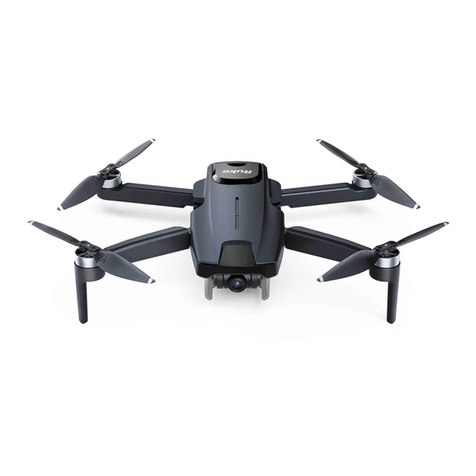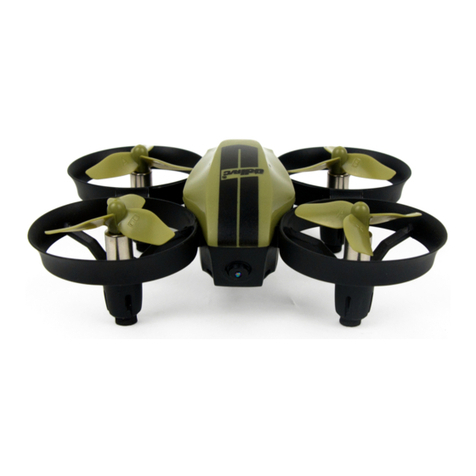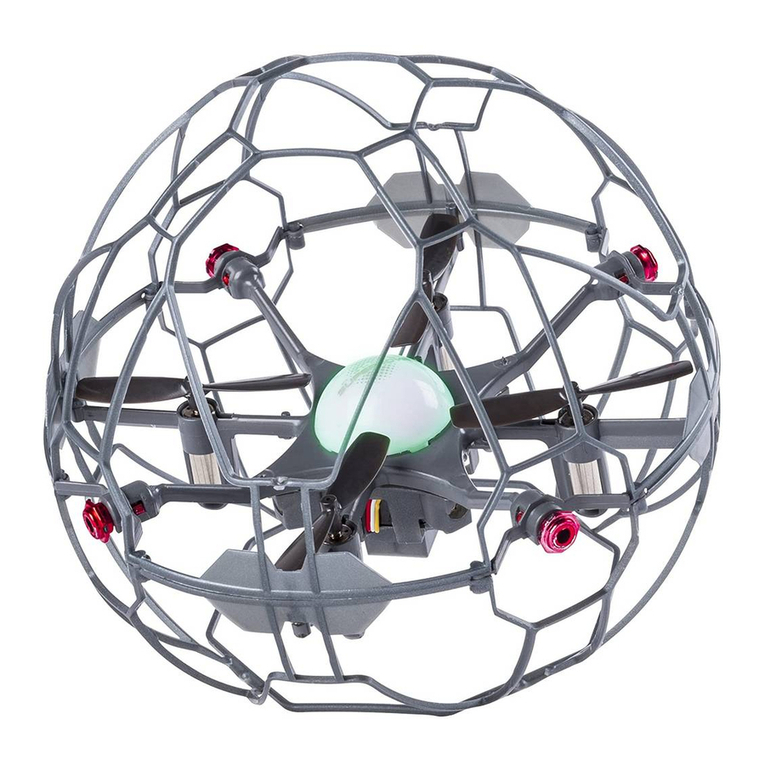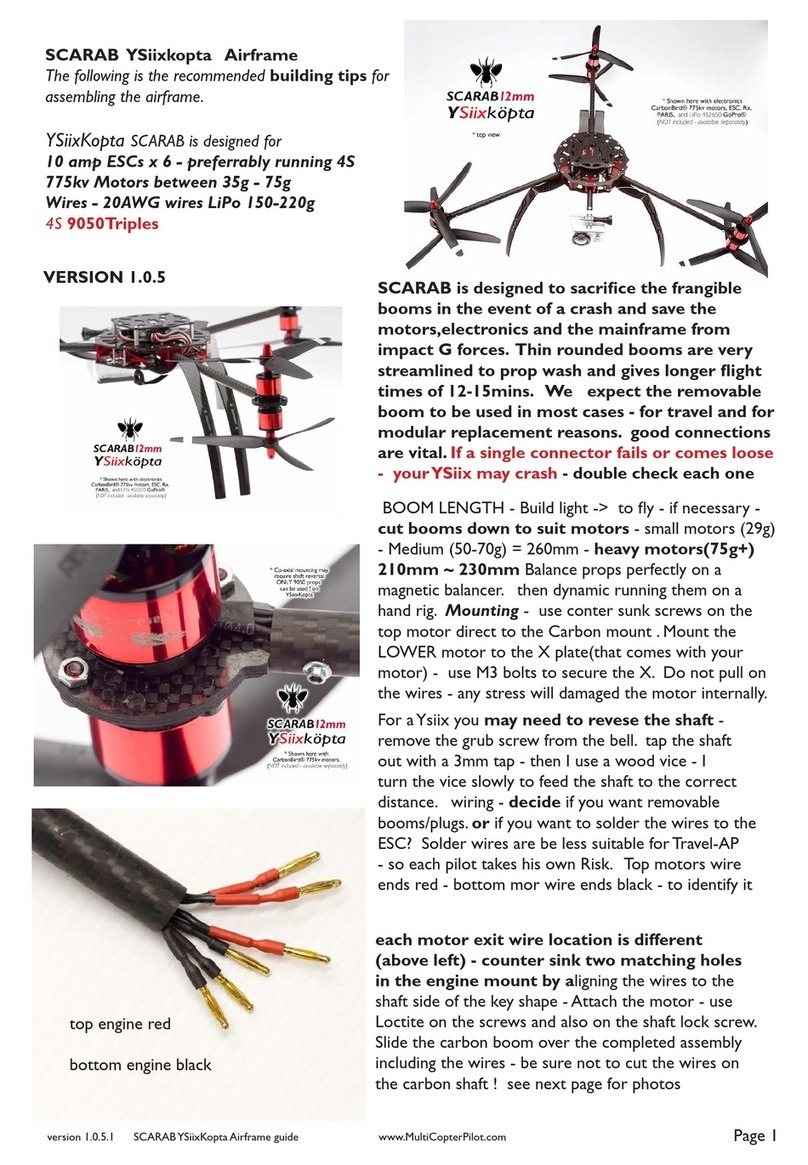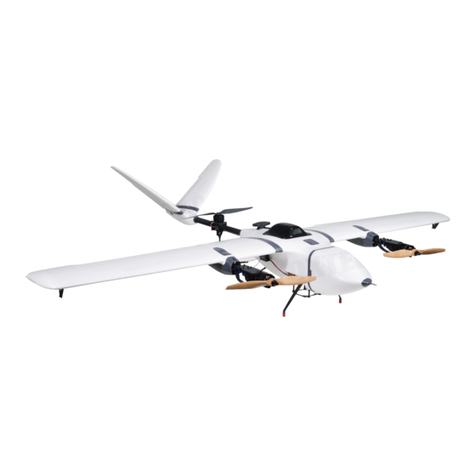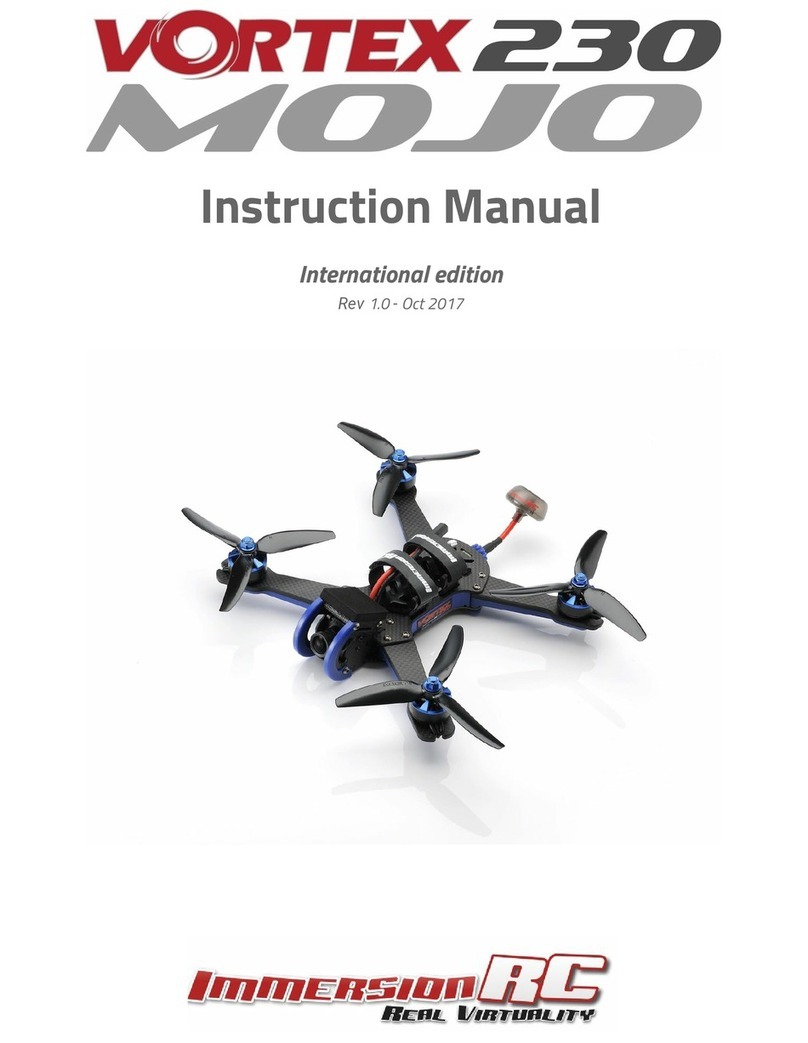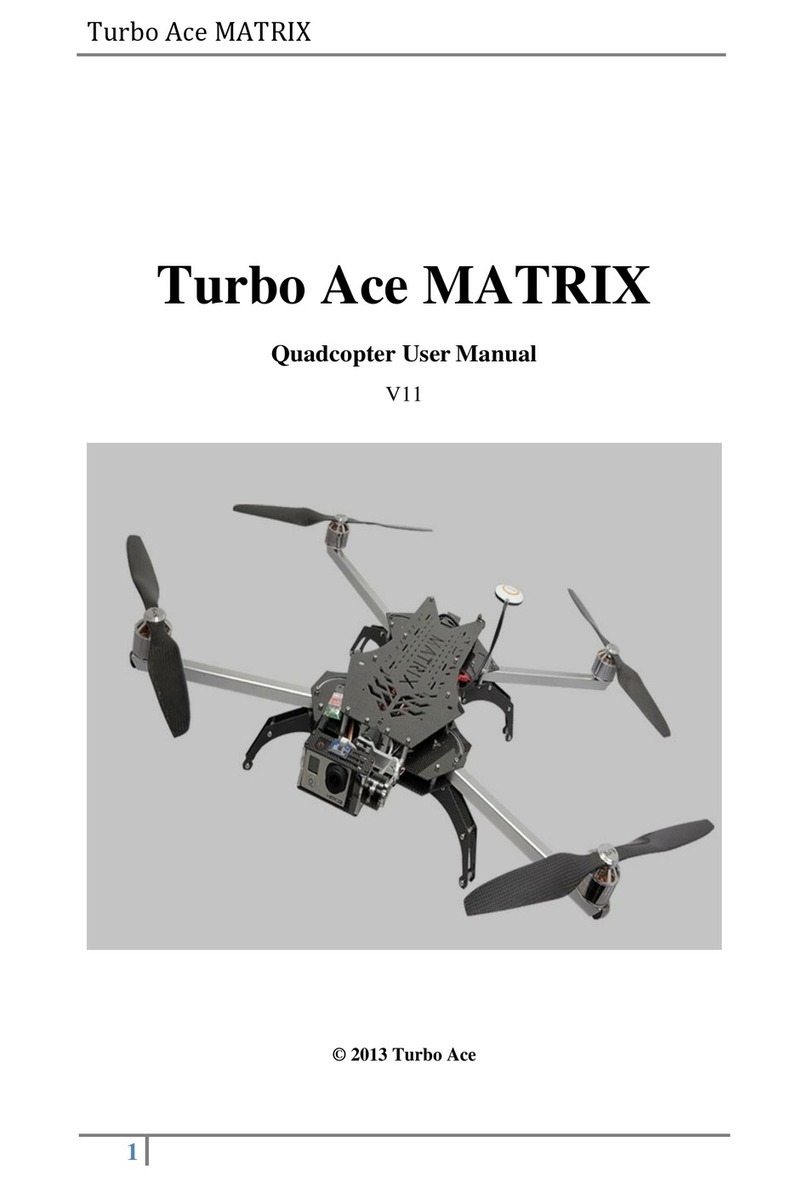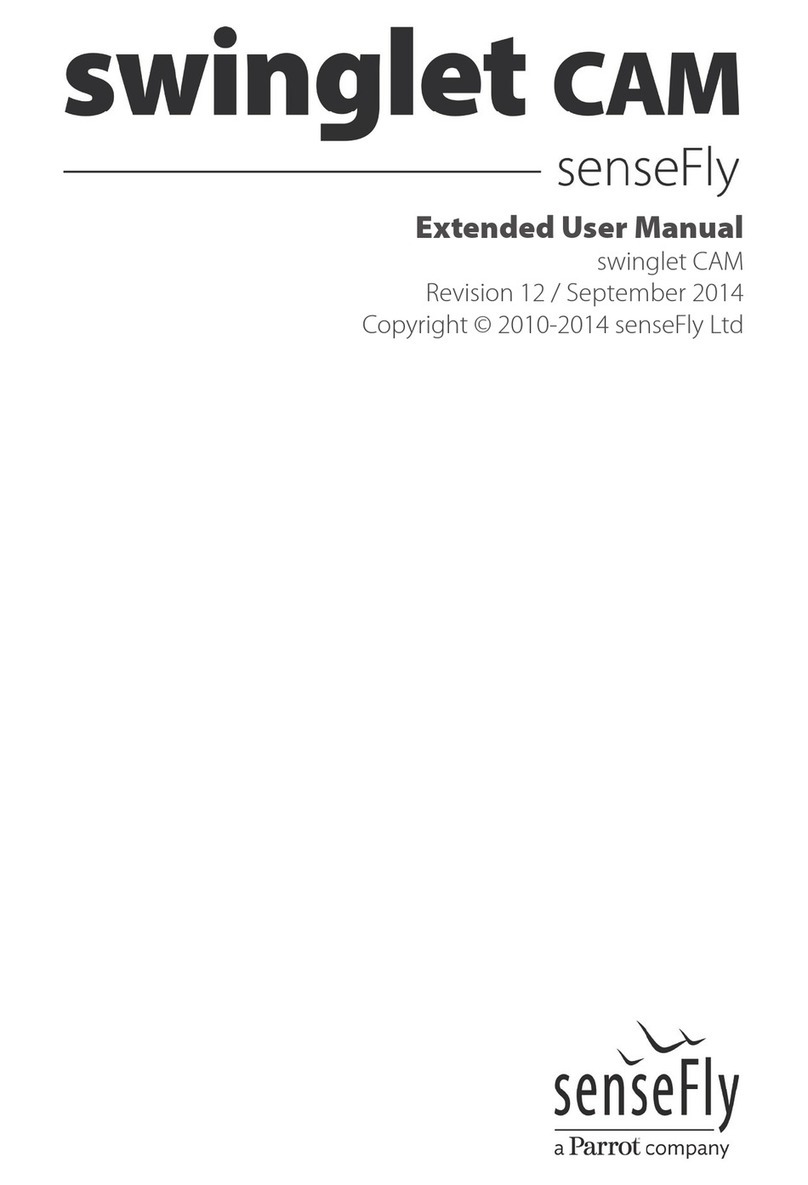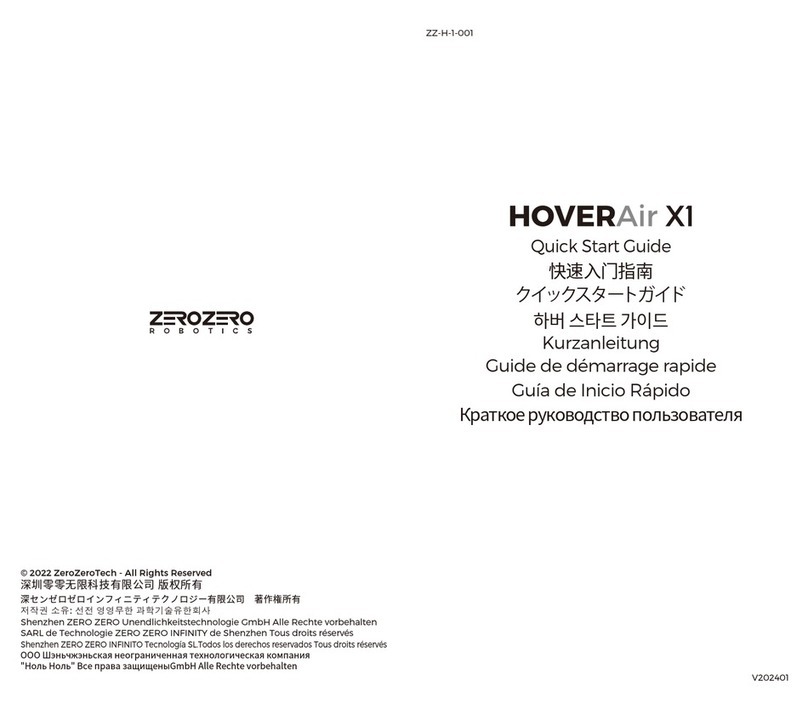Sharkan M Series User manual

SHARKAN FISHING DRONE
OPERATOR’S MANUAL
Operator’s
Manual
The Sharkan is our next-generation easy-to-use GPS-equipped 600mm quadcopter. The Sharkan
features an all-new high-power motor system with quick disconnect self-locking propellers. The
battery compartment is large and fits 4 and 6S LiPo batteries up to 6500mAh capacity (sold separately)
for long flight times.
Available as a Visual Line of Sight (VLOS) drone including a 2.4GHz 10-channel DSS transmitter and bait
release Servo and hosuing.
After familiarizing yourself with the basics of your new Sharkan series quadcopter, you’ll be ready to
use the Sharkan Flight and Fishing functions, like the GPS Flight Mode, Manual Flight and the Return
to Home function, in addition to programming your quadcopter to ensure the best flight performance
for the current flight conditions
It’s very important that you read through all of the information included with your
quadcopter and fully understand not only how to operate your quadcopter, but also to
fully understand the responsibility you have for its proper use - both for your safety
and the safety of others.
If you have any questions about setting up or flying your quadcopter after you’ve read this Operator’s
Manual and viewed the included How-To videos, please contact the Authorized Sharkan/Affiliates
service department using the information in the Service and Support section on page 3 before trying
to fly your new quadcopter.

DISCLAIMER
1) The Sharkan is supplied with attitude stabilization, altitude holding, position locking and autopilot
functions, it is supplied as a fishing Drone designed and optimised for Fishing.
2) We strongly recommend you to remove all the propellers during upgrading and parameters setup,
ensure all the connections are correct and keep the aircraft far away from the crowd, the
vulnerable and dangerous goods.
3) Sharkan accepts no liability directly or indirectly for the personal injuries and property loss caused
by the conditions below:
a. Damages or injuries incurred when users are drunk, taking drugs, drug anaesthesia, dizzy,
feeble, nausea and any other mental or physical discomfort.
b. Damages or injuries caused by subjective intentional operations of users.
c. Damages or injuries caused by the failure to follow the guidance of the user manual.
d. Damages or injuries caused by refit or replacement of non-Sharkan accessories or components.
e. Damages or injuries caused by products of third party or fake.
f. Damages or injuries caused by non-authorised and non-recommended operation.
g. Damages or injuries caused by the internal abrasion, corrosion, wear or aging.
h. Damages or injuries caused by continued flying under abnormal alarm.
i. Damages or injuries caused by being aware of flying under abnormal conditions.
j. Damages or injuries caused by flying in magnetic-interference zone, radio-interference zone,
no-fly zone or poor-sight zone.
k. Damages or injuries caused by bad weather.
l. Damages or injuries caused by crash, capsizing, fire, explosion, thunder strike, storm, flood,
tsunami, land subsidence, avalanche, earthquake or some other disastrous accidents.
m. Damages or injuries caused by infringement of data, audio or video materials recorded by the
aircraft.
n. Damages or injuries caused by misuse of battery.
o. Other conditions that are not covered by the range of liability of Sharkan and it’s authorised
Agents.
CONTACT
FLIGHT CONTROLLER FIRMWARE UPDATES
Periodically, updates to the flight controller firmware may be released that provide enhancements
and fixes that improve flight performance and user functions. For information about updating the
flight controller firmware using the Autopilot Configuration program, see the Updating Flight
Controller Firmware section on pages 32 and 33.

HOW TO VIDEOS
An assortment of various How-To videos are provided on the Website www.sharkan.co.za
/Youtube and WhatsApp (on request). We strongly recommend watching these videos to help you
visually understand the most important aspects of setting up and flying your new quadcopter.
REPLACEMENT PARTS
We stock a complete assortment of common replacement parts, such as motors, ESCs, propellers
and more for your Sharkan quadcopter. For more information, see the Replacement Parts section
on page 36.
TIPS AND SUGGESTIONS
This section includes a number of important tips and suggestions that we recommend you
familiarize yourself with before flying your new quadcopter.
Please read these tips and suggestions before flying. They’re important!
All of these tips and suggestions are explained in greater detail throughout this Operator’s Manual.
• A 4 0R 6S LiPo battery up to 6500mAh can be used to power the quadcopter. The battery
dimensions should not exceed 165 (L) x 50 (W) x 50 (H) (The battery must be fitted with a female
XT90 plug.)
• When you plug your LiPo battery into the quadcopter, it’s important that the quadcopter be sitting
on a flat, level surface and that you wait to move the quadcopter for at least 10 seconds and never
before the navigation lights starts flashing, after plugging your LiPo battery in to allow the gyros and
the flight controller to initialize.
• The quadcopter’s propellers are thin and very sharp, they can still be very dangerous. Be careful!
Do not allow your fingers, hands or other body parts to come into contact with the spinning
propeller blades or serious injury will result!
• The compass must be calibrated prior to the first flight of your new quadcopter. After this initial
calibration process, the calibration process must be repeated under any of the conditions listed in
the Calibrating the Compass section on pages 12 through 14.
• The quadcopter features three Flight Modes – Manual Mode, GPS Mode and Return to Home. We
strongly suggest learning to setup and fly the quadcopter in the Manual Flight Mode first, then learn
about using the GPS Flight Mode and the Return to Home function.
• In the default configuration, the quadcopter has a maximum altitude feet (50 meters) and 500
meters radius distance from the transmitter. This to comply with Civil Aviation Authority’s
requirement that the craft not be flow above 50m and within Visual Line of Sight (VLOS)
NEVER EXCEED THE ALTITUDE AND FLIGHT DISTANCE LIMITS AT
ANY TIME FOR ANY REASON!

• Before switching on the transmitter ensure the throttle is DOWN and all switches are in the UP
Position. Without doing this the Transmitter and Receiver will not bind and you will have no control
of the Quadcopter
• If you don’t push the throttle control stick forward within 5 seconds of arming the motors, or if
you’re flying and pull the throttle control stick all the way back to turn the motors OFF after landing,
you will need to re-arm the motors if you don’t push the throttle forward again within 3 seconds.
This is a safety feature to help prevent accidentally turning the motors ON, which could result in
injury.
• While arming and disarming (starting and stopping) the motors the THROTTLE (Left Lever) must
be -100%, all the way DOWN. Should you should move the Right Lever while the Trottle is NOT
DOWN…. Then you will FLIP and DAMAGE your Quadcopter
• If the quadcopter loses its GPS lock while flying in the GPS Flight Mode, it will start to drift with
the wind, Pay attention to the quadcopter at all times! If at any time the quadcopter seems to be
flying unusually or you feel there is a problem, switch to the Manual Flight Mode and take over the
flight controls.
• Once you switch to the Return to Home function, you cannot switch directly to the GPS Flight
Mode. You can only switch to the Manual Mode, then after 1-2 seconds to GPS Mode.
• There are some instances that the Failsafe function may not work all the time and the quadcopter
could crash. For example, if the quadcopter does not have a GPS lock when the failsafe activates,
or if your LiPo battery fails or does not have sufficient power to return home. The Failsafe function
is not guaranteed to save your quadcopter, so it should not be relied upon as such.
• Prior to updating the flight controller firmware or calibrating the control sticks, you must remove
the propellers from the quadcopter! Updating the firmware and calibrating the control sticks can
cause the motors to turn on unexpectedly, causing extreme damage.
• Prior to flying using the GPS Flight Mode and using the Return to Home function, please read and
understand the warnings associated with each. For more information, see the GPS Flight Mode
Warnings section on page 20 and the Return to Home Function Warnings section on page 22.
FEATURES
• Easy to Operate and Fun to Fly Next-Generation Design
• Durable Factory-Assembled Frame with Good Visibility
• Large Battery Compartment Fits 4-6S LiPo Batteries Up to 6500mAh for Long Flight Times
• 2.4GHz 6-Channel Digital Transmitter and Receiver with minimum 500m Range, under 100mw
transmission
• Digital Programmable Flight Control System with Fail-Safe and Low-Voltage Protection

• Precise Hovering and Self-Levelling with GPS with Return to Home GPS Function
• Low Noise, High-Power Brushless Motors with Quick Disconnect Self-Locking Propellers
• Custom Programming and Updateable Flight Controller Firmware*
If you find a part missing or damaged, please contact the Authorized Sharkan Agents/Affiliates
service department using the information on the www.sharkan.co.za contact page.
Contents may differ in both appearance and what’s included depending on version, and are subject
to change at any time without notice. KIT CONTENTS FEATURES AND SPECIFICATIONS FEATURES
SPECIFICATIONS *Requires Mini USB cable.
SPECIFICATION
• Length:
• Width:
•Flying Weight:
M Series Approximately
S Series Approximately
E Series Approximately
• Propeller Size and Type:
M Series
S Series
E Series
• Flying Time: Varies Depending on
Battery, operating altitude, Weather
conditions, Approximately
• Motors/ESCs:
M Series
S Series
E Series
• Operating Temp
• GPS Hovering Precision:
E and S 48 M 55
E and S 48 M 55
1.6kg (Std battery)
2kg (Std battery)
2.4kg (Std battery)
All Carbon
12”
13”
15”
15-25 minutes without load
40A 620kv
40A 620kv
40A 320kv
: (-10ºC to 35ºC)
+/- 0.8M Vertical +/- 2.5M Horizontal

• Maximum Yaw Angular Velocity:
Maximum Ascent/Descent Speed
300deg/sec • Maximum Tilt Angle: 33 Degrees
+/- 4ms
KIT CONTENTS
If you find a part missing or damaged, please contact the Sharkan/Authorised Affiliates service
department using the information in the Service and Support section on page 3. Contents may
differ in both appearance and what’s included depending on version, and are subject to change at
any time without notice.
Factory-Assembled Sharkan Quadcopter with
Baitdropper
2.4GHz 6-Channel Digital Transmitter
Carbon Propellers with Quick release
attachments –Clockwise Rotation ‘Gold Hub’
(QTY. 2) and Counter-Clockwise Rotation ‘Silver
Hub’ (QTY2).
Operator’s Manual PDF,
Flight Controller Software and How-To Videos
12/220v Balance Charger
Battery Reader/Voltage Alarm*
XT90 Battery Adapter for Charger - 4mm Bullet
to XT90 Female
Mini USB Cable for Programming and Firmware
Updates**
* When your LiPo battery voltage drops to the low voltage cutoff value during flight, the LED
Condition Indicator will flash red rapidly to indicate you must land immediately. For extra
precaution, we suggest using a programmable LiPo Battery Voltage Alarm that can be mounted with
your LiPo battery inside the quadcopter. You are able to program the alarm to sound at a higher
cutoff voltage value to give you more time to safely land before the battery voltage drops too low
and results in a crash.
**Not required for basic flying, but programming is required for best performance.
WARNINGS AND SAFETY NOTES
These warnings and safety notes are important and must
be followed closely. Please abide by this information and
follow the instructions in this Operator’s Manual to ensure
maximum safety. It’s important that you fully understand
not only how to operate your quadcopter, but also to fully
understand the responsibility you have for its proper use -
both for your safety and the safety of others.

KNOW BEFORE YOU FLY
Your quadcopter is not intended for commercial use. It must be
used in a safe and legal manner only. By operating your
quadcopter, YOU accept full responsibility for its safe and legal use.
Follow all privacy laws and property laws when operating your
quadcopter, and especially when using a still or video camera. For
Safe Operation Guidelines, please visit the Civil Aviation Site for
RPAS (Remotely Piloted Aircraft Systems) at
http://www.caa.co.za/pages/rpas/remotely%20piloted%20aircraft
%20systems.aspx www.knowbeforeyoufly.org
http://knowbeforeyoufly.org/
PROPELLER SAFETY
Your Sharkan quadcopter’s propellers are thin and very sharp. They are spun by very powerful
Brushless motors and they can still be very dangerous.
The propellers must be removed from the motors whenever you calibrate the transmitter control
sticks or when you update the flight controller firmware, or whenever there’s any question about
safely operating the quadcopter.
• Do not attempt to fly the quadcopter if one or more of the propellers are damaged. Flying with
damaged propellers is not safe and can make the quadcopter fly uncontrollably. Check the
propellers prior to each flight. If a propeller appears damaged in any way, it should be replaced.
BE CAREFUL! DO NOT ALLOW YOUR FINGERS, HANDS OR OTHER BODY
PARTS TO COME INTO CONTACT WITH THE SPINNING PROPELLER BLADES
OR SERIOUS INJURY WILL RESULT!

LIPO BATTERY SAFETY
To ensure your safety, please read and carefully follow the guidelines in this section and any safety
information included with your LiPo battery.
It’s important that you follow these warnings closely. LiPo batteries are significantly more volatile
than Alkaline or NiCd and NiMH batteries.
Charging Safety: The LiPo battery must be charged with a LiPo balancing charger or fire will result.
Do not use or charge your LiPo battery unattended.
LiPo Explosions/Fire: All energy storage devices are dangerous. They contain stored (potential)
energy, which ifmishandled, will cause failure, and in some cases that failure can be very dangerous.
Avoid all conditions that cause battery failure. These conditions include, but are not limited to:
Severe Heat - Anything over 50 degrees C can limit the battery’s life. If heated to extremes (with
fire, a soldering iron, etc.), the battery may fail and/or explode! Severe Damage - Examplesof severe
damage would be: breaking the battery or putting a hole in the battery.
Over Charge - The charger is either the wrong type or it simply fails and puts more energy at a
higher voltage than the battery is designed to handle. LiPo batteries must never be charged above
4.2v per cell.
Over Discharge - This usually comes from an improper ESC that allows the voltage to go well under
3.0v per cell. Also, this term is sometimes used to mean exceeding “C” discharge rating. If the
battery is rated for 6000mah (6Amps) continuous discharge, do not discharge it at a continuous rate
of 7 amps! This will destroy the battery.
Warning Signs that Failure and Possible Explosion Might Occur: If you cause or observe any of the
conditions listed above, you can experience battery failure, so if any of these things do happen, be
prepared that the battery could fail.
a. Swelling of the Battery - Swelling is caused by internal pressure that goes beyond the
normal amount of pressure in every battery. This pressure makes the cell swell up like a
balloon. Do not use a SWOLLEN battery! A SWOLLEN battery is a battery that has failed and
needs to be discarded before explosion or fire results. Here is what to do with a battery
that is on the verge of exploding or is starting to show signs of exploding: Do Not Handle
Directly - The material spitting out (if it comes to that) is spitting out at as much as 1000ºC.
b. Try to Contain the Fire - We recommend always charging your LiPo battery using a LiPo
safety bag (available separately). If you don’t use a LiPo safety bag, we recommend a fire-
proof container with a lid be kept near the proximity of any battery being used or charged.
Fill the bottom with sand. Have this ready to use at a moment’s notice. If the battery looks
suspicious, put it in the container and drop another large amount of sand on top, then drop
the lid. Let it burn out. It will smoke and fume, but the sand will contain the sparks and
reduce the transfer of heat. A fire extinguisher will help, but it will not stop the chemical
reaction. The only thing that can be done is to contain the fire until the fire goes out.

c. Practical Advice for Using LiPo Batteries: While there are precautions that must be taken
and dangers that must be considered, LiPo batteries today are very safe and very easy to
use.
d. Here is a list of practical advice for using this type of battery. Assembly of the Battery - Do
not solder directly to the battery!
e. Charging - Always use a LiPo balance charger. Always make sure the settings on the charger
match the battery (voltage and amperage) and that the polarity is correct!
f. Never charge if the battery is hot (over ambient temperature or 50ºC). Let it cool first!
Storage - We suggest a fireproof container for storing any rechargeable batteries.
g. LiPo batteries in storage for an extended period of time should be stored at 60 percent of
their capacity. If storing for only a short time, then leaving them with a full charge is fine.
Never store them in a discharged state! Do not store the battery in high-heat conditions.
10º to 30ºF is acceptable.
h. Damaged Battery - Damaged battery’s must be discarded immediately. We suggest
removing the insulation from around the battery, then submerging the battery in a bowl of
saltwater for 24 to 36 hours. This will completely discharge the battery. Cut off the wires,
place the battery in a sealed bag, then discard it in the trash.
Never charge your LiPo battery unattended. Not ever! Never
charge your LiPo battery inside your car and Never leave your LiPo
battery in a place where it will be stored over 50ºC (i.e., in your car
in the summertime).
GENERAL WARNINGS
• The quadcopter should never be flown in rain, sand, mud, snow or dirt. The quadcopter is
manufactured with delicate components that must be kept dry and free of debris to ensure the best
flight performance. Exposure to moisture or excessive heat can result in damage that will not be
covered under warranty.
• Just because the quadcopter is powered by electric motors doesn’t mean that you shouldn’t exercise
caution when flying and operating it. The quadcopter can be very dangerous and cause bodily injury
if you do not fly it in a safe manner or do not pay close attention while flying it. You alone are
responsible for its actions during flight.
• We strongly suggest that when you first begin flying the quadcopter that you perform only basic
manoeuvres, until you are more familiar with its flight characteristics. Do not attempt to use the GPS
Flight Mode or the Return to Home function without first reading about and understanding how to
use these features. In addition, we don’t recommend installing the camera gimbal or using the FPV
system until after you’ve flown the quadcopter a couple of times. This will allow you to learn the steps
required for flight and allow you to become familiar with the quadcopter’s flight characteristics before
using these features.

• Always unplug your LiPo battery from the quadcopter after use.
• Always fly the quadcopter in a suitably large area free of obstructions. The quadcopter MUST ONLY
BE be flown outdoors. Make sure any spectators are behind you.
• Even though the quadcopter is equipped with a GPS that can hold the quadcopter in a stable hover
and perform automatic landings using the Return to Home function, the quadcopter is not an
autonomous drone. You must pay careful attention and fly it at all times.
• When using the GPS Flight Mode and/or the Return to Home function, if at any time the quadcopter
seems to be flying unusually or you feel there is a problem, switch to Manual Flight Mode and take
over the flight controls.
• The GPS must be locked for the GPS Flight Mode and the Return to Home function to work. Once
the GPS is locked and the motors are armed, the flight controller will record the current Home Point.
The Home Point determines the location the quadcopter will fly back to when you switch to the Return
to Home function.
• While the MOTORS ARE SPINNING and the Quadcopter is on the ground, you should never pull the
Pitch control stick (Right Stick) in any Direction unless the Throttle (Left Stick) completely Down (0
Throttle) or the quadcopter can flip over and crash.
RADIO CONTROL SYSTEM WARNINGS
• The radio system operates on the 2.4GHz frequency band. The 2.4GHz connection is determined by
the transmitter and receiver pair. Unlike ordinary crystal-based systems, the quadcopter can be flown
without frequency control.
• Always turn the transmitter ON before plugging your LiPo battery into the quadcopter and always
unplug your LiPo battery from the quadcopter before turning the transmitter OFF.
• Because the quadcopter is operated by radio control, it’s important to make sure you are always
using fresh transmitter batteries. Never allow the transmitter batteries to run low or you might
experience loss of control.
• Do not expose the transmitter to moisture or excessive heat and never attempt to disassemble or
modify any of the radio control system components.
• Do not cover the transmitter antenna in any way during use! Doing so can block the RF signal,
resulting in loss of control of your quadcopter.
• During use, hold the transmitter so that its orientated as close to vertical as possible at all times.
This provides the best RF signal between the transmitter and the receiver inside the quadcopter. Try
not to ‘follow’ the quadcopter with the transmitter, as this can result in a weakened RF signal.
If it’s ever necessary to pair the transmitter and receiver again, see the Binding the
Transmitter and Receiver section on pages 31 and 32

Antenna - Transmits the RF signal from the transmitter to the receiver inside the quadcopter.
Flight Mode Switch - Used to change Flight Modes. Choose from GPS Mode (1), MANUAL Mode (2)
and Return to Home (3). Also used in the Compass Calibration process. The Flight Mode Switch should
be left in the GPS Mode (1) position for the majority of flight. Mixing and Servo Reversing Switches -
Allows you to change the transmitter’s electronic mixes and change the direction of control travel. See
the Switch Setup section below for more information.
On/Off Switch - Turns the transmitter ON and OFF.
Pitch/Roll Control Stick - Controls the quadcopter’s Forward/Backward (Pitch) and Right/Left (Roll)
flight axes.
Pitch Trim Switch - Used to make fine-tuned adjustments to the pitch axis to level the quadcopter
during flight. Roll Trim Switch - Used to make fine-tuned adjustments to the roll axis to level the
quadcopter during flight. . Yaw Trim Switch - Used to make fine-tuned adjustments to the yaw axis to
keep the quadcopter from spinning right or left during flight
Bind Button - To bind Receiver to the Transmitter
Throttle/Yaw Control Stick - Controls the quadcopter’s Throttle (Power Up/Down) and Yaw (Spin
Right/Left) flight axes. Throttle Trim Switch - Used to make fine-tuned adjustments to the throttle axis
to keep the motors from turning ON when the throttle control stick is pulled all the way back
>
>
>
>
>
On/Off
Forward / Reverse
Roll Left / Right
Throttle - Take off
and Land
Steer left and right
Flight Mode Switch
(Switch C)
1. GPS Mode
2. Manual (only Gyroscope)
3. Return Home
Switch A
Bait dropper

SWITCH SETUP
Before flying your quadcopter, verify that the Flight Mode Switch, Trim Switches and the Mixing and
Servo Reversing Switches are in the positions described in the table below and shown in the photo
above. The Flight Mode Switch should be left in the GPS Mode (1) position for programming, takeoff,
normal landings and for the majority of flight. All four trim switches should be centered.
AUDIBLE TRIM SETTING SWITCHES
When the transmitter is turned ON and you press a trim switch, a short audible tone is heard. When
a Trim Switch is centered, a longer audible tone will sound..
QUADCOPTER OVERVIEW
Use the information in this section to familiarize yourself with the basic layout of your Sharkan
quadcopter, including motor direction, front, back, left and right orientation, control connections
and the LED Condition Indicator.
LED CONDITION INDICATOR
The LED Condition Indicator will flash red and/or green to indicate the current status of the
quadcopter. Use the table below to determine the current status based on LED condition.
PREPARING FOR FLIGHT
1) Follow the information in this section to install the transmitter batteries, install the
propellers, install your fully charged LiPo flight battery, initialize the gyros and flight
controller, and calibrate the compass to prepare your Sharkan quadcopter for flight.
2) Aside from installing the transmitter batteries, each of these steps must be completed in
the order described in this section, unless otherwise noted.
Failure to follow these steps correctly and in the order written may result in your
quadcopter not flying as designed or not flying at all.
Do not attempt to fly your quadcopter yet using any other Flight Mode (GPS or
Return to Home). In addition, do not install the camera gimbal or the FPV system (FPV
version only) yet.
It’s important that you first learn to setup and fly your new quadcopter using the GPS
Flight Mode without worrying about using these more advanced features.

CALIBRATE THE COMPASS
Please follow the tips below when calibrating the compass. Completing the compass calibration
process correctly is important to ensure the quadcopter will fly properly.
CALIBRATING THE COMPASS IS REQUIRED FOR FLIGHT! DO NOT SKIP THIS PROCEDURE!
1) When calibrating the compass, do not do so in an area that may cause magnetic interference,
such as a parking garage, near an area with steel reinforcement, near metal fencing, under
high voltage power lines etc. In addition, remove keys, cell phones and any other metal objects
from your pockets that could interfere with the calibration process.
2) You should perform the compass calibration process in the location that you will be flying the
quadcopter at.
3) Switch the Transmitter on, Place the Drone on a level surface, Plug the drone battery in, Leave
the Drone dead still and allow it to BOOT UP, Once the LED Condition Indicator is flashing then
Activate Calibration mode, This is done by Cycling through Switch C…. GPS Mode – Manual
Mode –Return Home –Manual –GPS, Not to Fast Not to Slow and feel each CLICK. After 6-9
Cycles the Flashing light will turn Solid Yellow. You are now ready to Calibrate
4) Pick the Drone Up, Hold it level, Now turn around Clockwise, Keep Turning till the Solid Yellow
light turns Solid Green (Approx 1.5 turns).
5) Now lift the nose of the Drone upwards. Turn around in an Anti Clockwise direction, Approx 1
full turn.

6) The LED Condition light will now begin flashing again. Should it present a Double Red Flash.
Unplug the drone, make sure there is no Magnetic/Electrical Interference where you are.
Unplug the Drone and re-do the procedure.
7) If the light is flashing Yellow or Green. Place the Drone back on level ground, unplug the
Battery and then plug the battery in again to allow the Drone to Boot with the new Data Input.
8) After the initial calibration process, the calibration process must be repeated under any of the
following conditions:
a. If you fly in a location that is greater than 30 kilometers away from the location you
last calibrated the compass at.
b. If you fly in a location with an altitude difference that is greater than 150 meters) from
the location you last calibrated the compass at.
c. If the quadcopter drifts noticeably and it’s not caused by wind interference (cross-
wind, etc).
PREPARING FOR FLIGHT
1) Follow the information in this section to install the transmitter batteries, install the
propellers, install your fully charged LiPo flight battery, initialize the gyros and flight
controller, and calibrate the compass to prepare your Sharkan quadcopter for flight.
2) Aside from installing the transmitter batteries, each of these steps must be completed in
the order described in this section, unless otherwise noted.
3) Failure to follow these steps correctly and in the order written may result in your
quadcopter not flying as designed or not flying at all.
4) Do not attempt to fly your quadcopter yet using any other Flight Mode (GPS or Return to
Home).
5) It’s important that you first learn to setup and fly your new quadcopter using the GPS Flight
Mode without worrying about using these more advanced features.
INSTALLING THE TRANSMITTER BATTERIES
1) Remove the battery cover and pull out the battery holder.
2) Install 4 new ‘AA’ alkaline batteries into the battery holder, double-checking to make sure
that the polarity is correct, then reinstall the battery holder and the battery cover.
3) Do not mix old and new batteries and do not mix battery types. The transmitter is designed
to use Alkaline batteries only.
4) Using NiCd, NiMH or Lithium batteries will result in an error due to incorrect voltage and
the transmitter will not function properly.

INSTALLING THE PROPELLERS
1) Being careful not to cross-thread them, carefully thread the propellers onto the Quick
Release Mounts shafts and finger tighten them.
2) The two Gold hub propellers are reverse thread (turn counter-clockwise to tighten) and
the two silver hub propellers are standard thread (turn clockwise to tighten).
3) Use the top view photo on the previous page to determine what motor to install each
propeller on, either clockwise rotation or counter-clockwise rotation.
CHARGING YOUR LIPO BATTERY
FIRE WARNING:
IMPROPER USE WILL CAUSE FIRE, PROPERTY DAMAGE AND BODILY HARM!
CONSTANT SUPERVISION REQUIRED AT ALL TIMES DURING CHARGING AND USE!
READ ALL SAFETY PRECAUTIONS INCLUDED WITH YOUR LIPO BATTERY AND YOUR CHARGER
BEFORE USE!
1) Fully charge your LiPo battery using a LiPo balance charger.
2) Make sure to follow all precautions included with both your LiPo battery and your charger
to ensure maximum safety.
3) Your Sharkan quadcopter features a male XT90 power connector.
4) In addition, an XT90 Battery Adapter for Charger is available separately to charge your LiPo
battery.
INSTALLING YOUR LIPO BATTERY AND INITIALIZING THE GYROS AND FLIGhT CONTROLLER
1) Fully install your fully charged LiPo flight battery into the battery tray, making sure to push
your LiPo battery as far forward as possible into the body.
2) Do not plug your LiPo battery into the power connector yet.
3) Pull the throttle control stick all the way back, verify that the Flight Mode Switch is in the
GPS Mode (1) position, then turn the transmitter ON.
It’s important that when you plug your LiPo battery into the quadcopter in the next
step, that the quadcopter be sitting on a flat, level surface and that you wait to move
the quadcopter for 10 seconds after plugging your LiPo battery in to allow the gyros
and flight controller to initialize.
4) Place the quadcopter right-side up on a flat, level surface, then plug your LiPo battery into
the power connector.
5) Three quick audible tones will sound, followed by a single audible tone.
6) Do not move the quadcopter for 10 seconds after plugging your LiPo battery in to allow
the gyros and flight controller to initialize Only move the Quadcopter once the LED
Condition Light begins flashing
7) Carefully push any excess wiring and connectors into the back of the body, especially the
JST Balance Plug.

INSTALLING THE PROPELLERS
1) Being careful not to cross-thread them, carefully thread the propellers onto the Quick
Release Mounts shafts and finger tighten them.
2) The two Gold hub propellers are reverse thread (turn counter-clockwise to tighten) and
the two silver hub propellers are standard thread (turn clockwise to tighten).
3) Use the top view photo on the previous page to determine what motor to install each
propeller on, either clockwise rotation or counter-clockwise rotation.
FLYING YOU SHARKAN QUADCOPTER
1) After calibrating the compass, your quadcopter is now ready for flight. Follow the steps in
this section to arm the motors and fly your quadcopter in GPS Mode.
We strongly recommend flying your quadcopter in the GPS Flight Mode for at least the first few
flights before attempting to use any other Flight Mode or function. This will allow you to become
familiar with the quadcopter’s flight characteristics, since the majority of flying is done in the
GPR Flight Mode.
ARMING THE MOTORS
1) Before the throttle will operate, the motors must be armed.
2) Before arming the motors and flying your quadcopter, make sure that you’ve completed
the following steps:
a. Fully charge and install your LiPo battery,
b. turn the transmitter ON
c. make sure the Flight Mode Switch is in the GPS Mode (1) position.
d. Set the quadcopter on a flat level surface,
e. plug in your LiPo battery and allow the gyros and the flight controller to initialize for
10 seconds.
f. Complete the compass calibration process in the location you will be flying.
g. The LED Condition Indicator should be flashing:
Yellow (Manual Mode),
Double Red (Acquiring GPS Satelites),
Single Green (More than 8 GPS Satelites),
20 Strobing Green Lights, (GPS is good)
Single slow Green flash (GPS Mode)
h. Perform CSC (Combined Stick Command) Push the left
control stick and the right control stick to the lower Right
and lower Left corners as shown in the photo, then
release the control sticks.

i. The motors are now armed and spinning
j. Within 3 seconds, push the throttle control stick forward to keep the motors from
cutting out (10%+)
k. Turning the Motors off, Perform an outward CSC
If you don’t push the throttle control stick forward within 3 seconds, or if you’re flying
and pull the throttle control stick all the way back to turn the motors OFF after landing,
you will need to re-arm the motors again if you don’t push the throttle forward again
within 3 seconds
PROPELLER SAFETY
The quadcopter’s propellers are thin, VERY HARD and SHARP. Although they are
somewhat flexible to prevent damage during minor mishaps, they can still be very
dangerous.
Do not attempt to fly the quadcopter if one or more of the propellers are damaged. Flying with
damaged propellers is not safe and can make the quadcopter fly uncontrollably. Check the
propellers prior to each flight. If a propeller appears damaged in any way, it should be replaced.
INSTALLING THE PROPELLERS
1) Being careful not to cross-thread them, carefully thread the propellers onto the Quick
Release Mounts shafts and finger tighten them.
2) The two Gold hub propellers are reverse thread (turn counter-clockwise to tighten) and
the two silver hub propellers are standard thread (turn clockwise to tighten).
3) Use the top view photo on the previous page to determine what motor to install each
propeller on, either clockwise rotation or counter-clockwise rotation.

FLIGHT CONTROLS
1. This section details how to control your quadcopter. Each diagram displays what the
quadcopter will do when a control stick is moved either up or down, or right or left.
Left Control Stick: Move
the left control stick left
and right to spin the
quadcopter left and right.
TOP VIEW
(YAW)
Right Control Stick: Move
the right control stick
forward and backward to
move the quadcopter
forward and backward.
FORWARD
SIDE VIEW
REVERSE
(PITCH)
Right Control Stick: Move
the right control stick left
and right to move the
quadcopter left and right
REAR VIEW
LEFT
RIGHT
(BANK)
Left Control Stick: Move
the left control stick
forward and backward to
move the quadcopter up
and down ( Increase and
Decrease the throttle).
MOVE UP MOVE DOWN
SIDE VIEW
GPS FLIGHT MODE FLYING TIPS
Your Sharkan quadcopter is a powerful, high-performance quad-rotor heli and you
must use caution at all times when flying it. In this section we’ve provided some basic
flying tips to help you get started.
1) If at any time during flight you begin to lose control of the quadcopter and are unable regain
control before crashing into something or someone, pull the left control stick (throttle) all the
way back to shut the quadcopter down, Switch the Transmitter off to allow the Flight Control
Computer to take Over and Auto Return the Quadcopter back to Home.
2) Always fly the quadcopter in a suitably large area free of obstructions.
3) Flying in strong or gusty winds can make the quadcopter more difficult to control and should
not be attempted until you are a very proficient flier.
4) When moving the control sticks, use only small, smooth control inputs. Using large, abrupt
control inputs can cause you to over-control, making the quadcopter more difficult to fly and
possibly result in a crash.

5) Quadcopters in general do not need to be re-corrected as helicopters do, so control inputs
should be given and the control sticks returned to center before the next control input.
6) When the front of the quadcopter is facing toward you, the right and left roll and yaw controls
will seem reversed. Imagining yourself sitting in the “cockpit” will help you get used to this.
GPS FLIGHT MODE FLYING BASICS
1) When learning to fly, we suggest always trying to keep the quadcopter about 1m off the ground
and in a relatively small flying area.
2) To be successful when learning, make small control inputs. Over-controlling is a mistake all new
pilots make. Never move the control sticks more than halfway except the throttle, and only
when necessary.
3) You should have completed the following steps prior to flight:
a. Fully charge and install your LiPo battery.
b. Pull the left control stick all the way down (back) and turn the transmitter ON.
c. Verify that the transmitter Trim Switches are centred
d. Flight Mode Switch is in the GPS Mode (1) position.
4) Plug your LiPo battery in and initialize the gyros and flight controller.
5) Make sure to wait a minimum of 10 seconds after the final single audible tone before moving
the quadcopter, wait for the LED Condition light to Flash.
6) Calibrate the compass. (This only needs to be done before your first flight or under any of the
circumstances described in the Calibrating the Compass section on pages 12 through 14).
7) Verify the LED Condition Indicator Strobe flashes Green, 20 times indicating GPS Lock is good to
fly.
8) then arm the motors. :
e. With the front of the quadcopter facing away from you,
f. Slowly push the throttle up 10% to keep the propellers spinning.
g. Continue to push the throttle forward to increase the speed of the motors and take off. 20%
above center ie. 1st notch over centre.
h. Remember, you must advance the throttle within 3 seconds of arming the motors or you’ll
need to re-arm the motors.
i. Gently move the right control stick as required in small increments to keep the quadcopter
hovering in the same general area about 3 feet off the ground.
j. At the same time you will need to increase or decrease the throttle to keep the quadcopter
hovering a consistent distance off the ground. As you take off, it’s normal for the quadcopter
to drift backward until you climb higher out of the ground effect.
k. To counter-act this, gently push the right control stick forward.
l. While making small adjustments to the throttle to keep the quadcopter hovering in the
same general area about 3 feet off the ground, gently move the right control stick to the
right and left and see how the quadcopter banks and moves to the right and left, then slowly
move the right control stick forward and backward and see how the quadcopter banks and
moves forward and backward.

m. Remember, make gentle, small control inputs. Now gently move the left control stick to the
right and left and see how the quadcopter spins around its vertical axis right and left.
n. Repeat moving the right and left control sticks slowly to the left and right, and forward and
backward to get used to how the quadcopter moves, all while at the same time making small
adjustments to the throttle to keep the quadcopter hovering about 3 feet off the ground.
o. Now try placing the quadcopter in a stable hover and release the control sticks.
9) Practice Patterns:
a. First, practice hovering in a small space, using small control inputs to keep the quadcopter
in one place (Fig. 1).
b. Next, practice flying a square or rectangular pattern (Fig. 2),
c. then practice flying in a figure-8 pattern (Fig. 3).
d. After getting better at flying these patterns, practice flying different patterns, spinning the
quadcopter 360º and changing the position at which you stand relative to the front of the
quadcopter (Fig. 4).
GPS FLIGHT MODE WARNINGS
1) Please read and understand the warnings in this section prior to flying your quadcopter using
the GPS Flight Mode.
2) Failure to follow these warnings can result in erratic performance or worse, a crash.
3) When your LiPo battery is plugged in and the gyros and flight controller have been initialized,
the quadcopter will automatically attempt to acquire a GPS lock.
4) Please observe the following:
a. The quadcopter should have a clear view to the sky.
b. There should be no trees, buildings or other obstructions nearby that could affectthe ability
to receive a GPS signal.
c. Cloud cover can affect the GPS signal.
d. The GPS works best when the sky is clear.
5) In some cases it can take up to two minutes or more to acquire a GPS lock.
6) The GPS must be locked (LED Condition Indicator flashing Green) for the GPS Flight Mode to
function. The GPS will not function if there is no GPS lock (LED Condition Indicator flashing single
Yellow).
7) The quadcopter is not an autonomous drone. You must pay careful attention and fly it at all
times.
8) When in the GPS Flight Mode, if at any time the quadcopter seems to be flying unusually or you
feel there is a problem, switch to the Manual Flight Mode and take over the flight controls.
This manual suits for next models
2
Table of contents
Popular Drone manuals by other brands
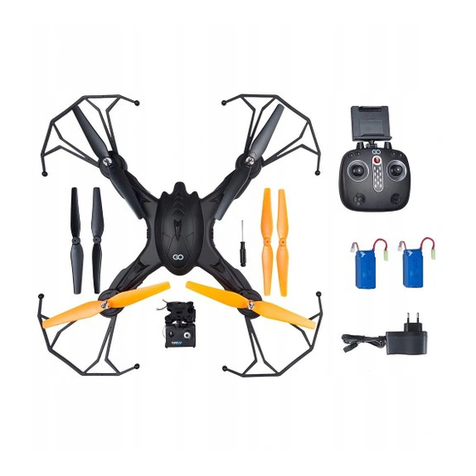
Goclever
Goclever PREDATOR FPV quick start guide
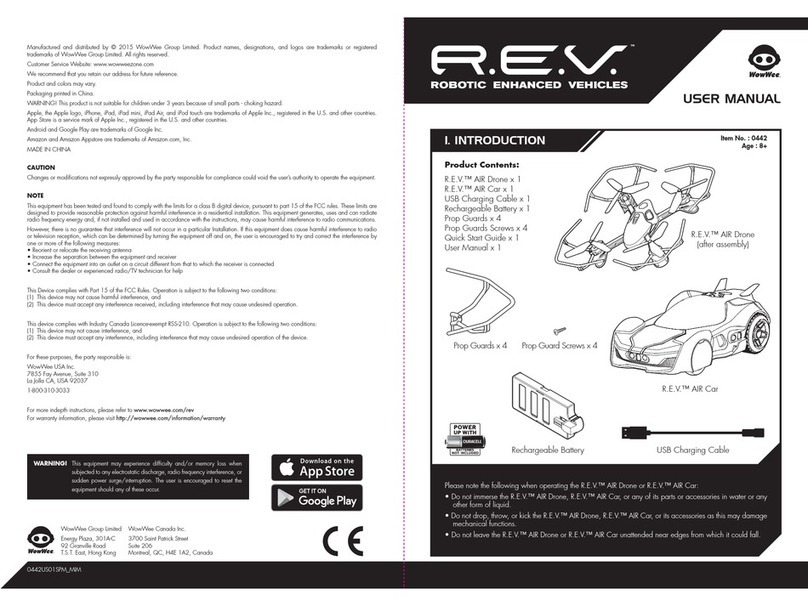
WowWee
WowWee R.E.V. 0442 user manual
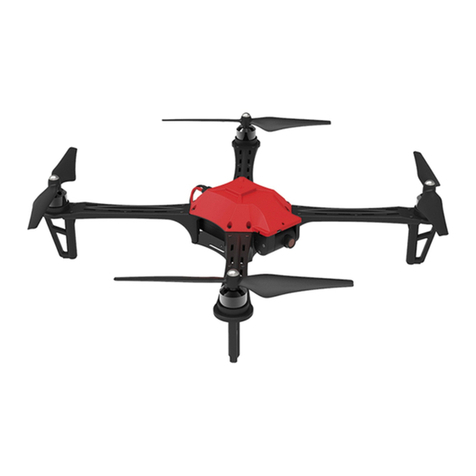
Skydroid
Skydroid Yunzhuo MX450 UAV user manual
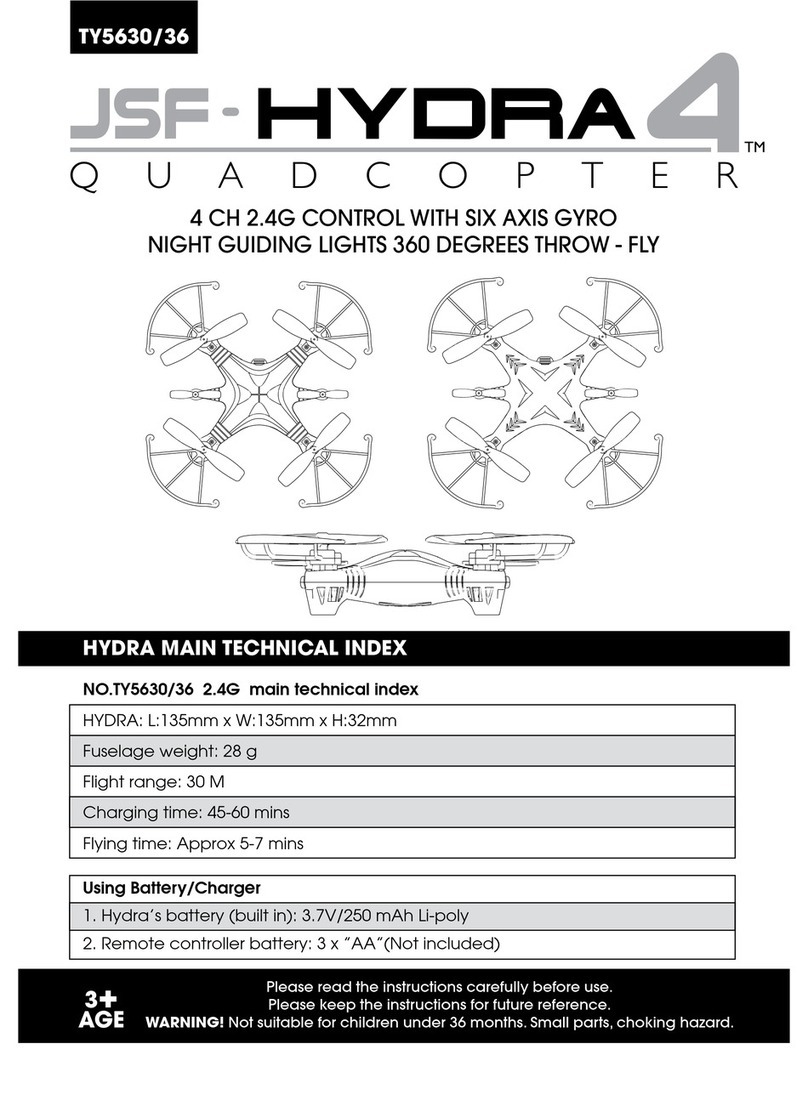
Wilton Bradley
Wilton Bradley JSF HYDRA 4 TY5630 user manual
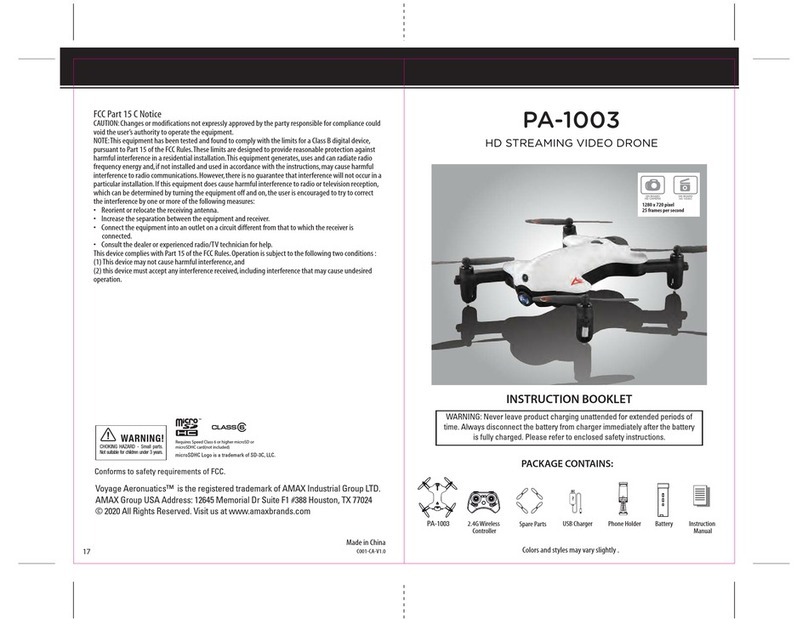
Voyage Aeronuatics
Voyage Aeronuatics PA-1003 Instruction booklet
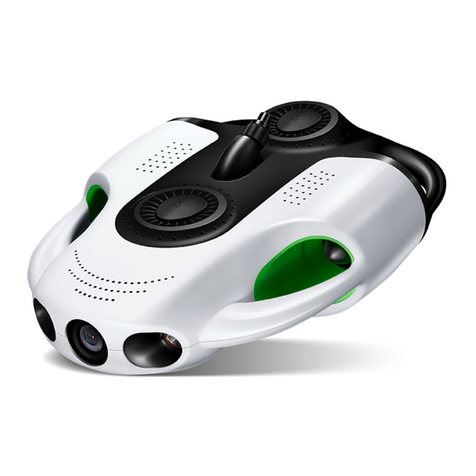
Youcan Robot
Youcan Robot BW Space Pro quick start guide
